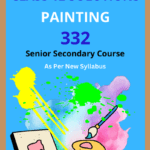NIOS Class 12 Painting Chapter 2 Art from Maurya to Gupta Period Solutions to each chapter is provided in the list so that you can easily browse throughout different chapters NIOS Class 12 Painting Chapter 2 Art from Maurya to Gupta Period and select need one. NIOS Class 12 Painting Chapter 2 Art from Maurya to Gupta Period Question Answers Download PDF. NIOS Study Material of Class 12 Painting Notes Paper 332.
NIOS Class 12 Painting Chapter 2 Art from Maurya to Gupta Period
Also, you can read the NIOS book online in these sections Solutions by Expert Teachers as per National Institute of Open Schooling (NIOS) Book guidelines. These solutions are part of NIOS All Subject Solutions. Here we have given NIOS Class 12 Painting Chapter 2 Art from Maurya to Gupta Period, NIOS Senior Secondary Course Painting Solutions for All Chapter, You can practice these here.
Art from Maurya to Gupta Period
Chapter: 2
PAINTING
Lion capital of sarnath (PIC. 4)
| Title | Lion Capital |
| Medium | Sand stone |
| Date | Circa 3rd C.B.C |
| Finding site | Sarnath |
| Size | Height-213.5cm |
| Artist | Unknown |
| Collection | Sarnath Site Museum |
The sculpture of four lions grouped together, is the capital (Top part of a pillar) of the Stambh of Sarnath’s Deer park, which was constructed during the time of Ashoka. It is believed that it was at this site, Buddha gave his first sermon, thereby “turning the wheel of the law”. It was excavated in 1905.
The Chinese traveler Hsuan-Tsang mentioned of a seventy-foot high pillar with shining polish standing at the same site.
This composite sculpture displays a highly advanced form of art. This sculpture has been adopted as the emblem of Govt. of India.
Chauri bearer (Pic. 5)
| Title | Chauri Bearer (yakshini) |
| Medium | Sand stone |
| Date | circa 3rd C.B.C |
| Finding site | Didarganj, Patna |
| Size | Height 162.5cm |
| Artist | Unknown |
| Collection | Patna Museum, Patna |
Because of the technique, surface refinement and high polish, scholars believe that the beautiful life-sized sculpture belongs to the Maurya phase. This female figure is also identified as a Yakshini and is often said to be the “Mona Lisa” of Indian Art. The figure is carved in the round. It is the perfect modeling of a female body. There are very few sculptures in Indian art that surpass its beauty.
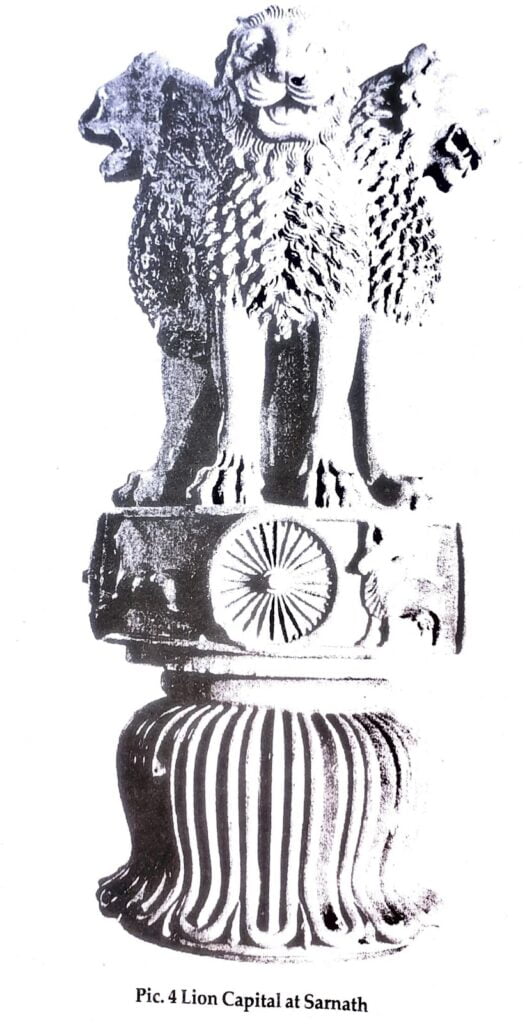
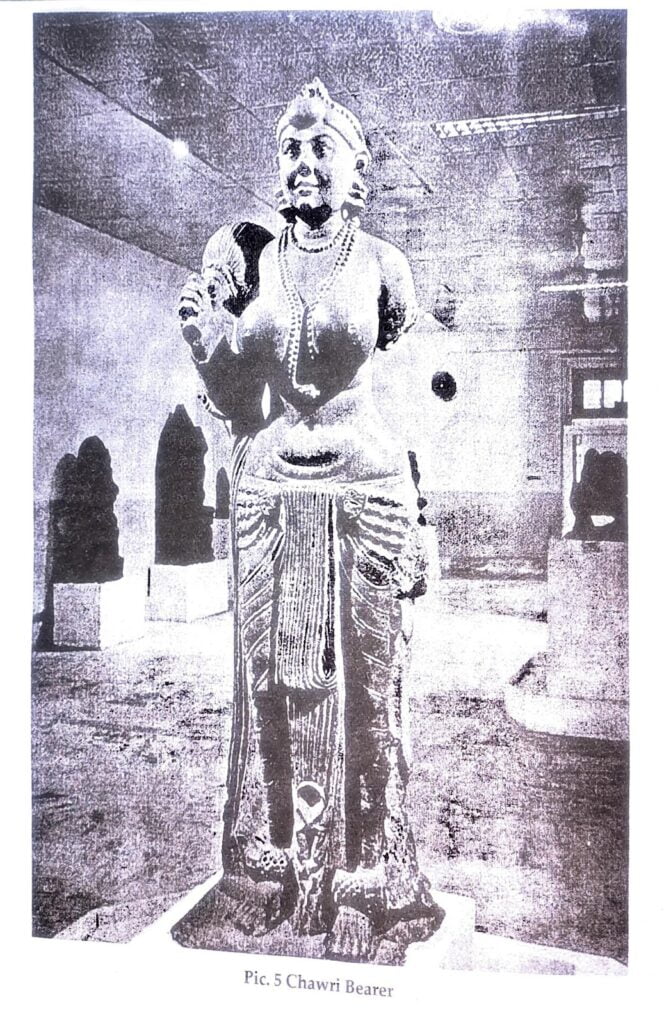
Stupa-I at sanchi (pIC. 6)
| Title | The great Stupa of Sanchi |
| Medium | Sand stone |
| Date | Circa 3rd C.B.C through Ist C.A.D |
| Finding site | Sanchi, Madhya Pradesh |
| Size | Diameter-36 meters |
| Artist | Unknown |
Stupa I is the biggest Stupa at Sanchi. It is also known as Mahastupa. It was built during the time of Ashoka, and was enlarged to the current size by the Sungas. Probably a portion of the relics of Sakyamuni (Buddha) was placed inside the Stupa. During the second half of the first century B.C. the Satavahanas constructed the four beautifully carved toranas or Gateways.

Jain Tirthankar (Pic. 7)
| Title | Jain Tirthankar |
| Date | Gupta period 5th C.A.D |
| Finding site | Mathura |
| Size | 95×60cm |
| Artist | Unknown |
| Collection | State Museum, Lucknow, U.P. |
A number of Jain images were found near Vidisha, which belonged to the early Gupta period.
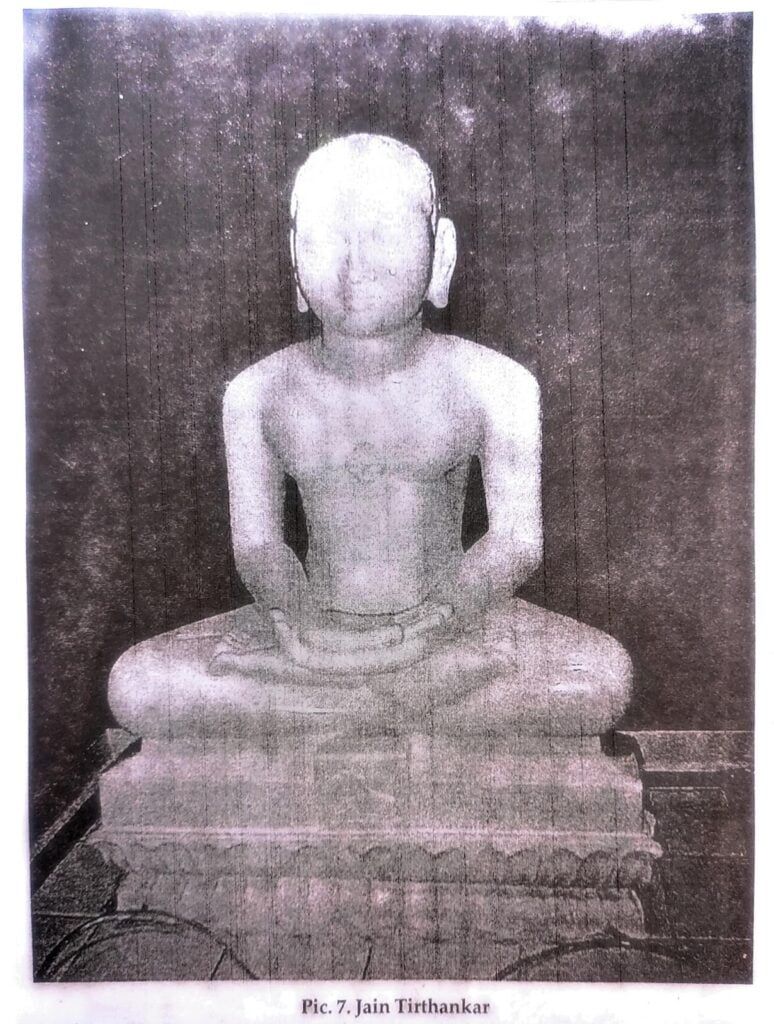
This image is of a Jain Tirthankar, seated on a square pedestal in Vajraparyankasana mudra. This image of Mahavira Swamy, the 24th Tirthankar, is made in the typical Buddhist and Jain style of the Kushana period.
In his teachings Mahavir Swamy stressed on freeing the human being from the cycle of birth and death, which can be achieved by practicing the Tri Ratna (three gems of action) like faith, righteous work and truthful words.
The artist tried to express the Triratan in this image.
Seated Buddha (Pic. 8)
| Title | Sarnath Buddha |
| Medium | Buff Sand stone |
| Date | Gupta period, 5th century A.D. |
| Finding site | Sarnath, U.P. |
| Size | Height – 160cm. |
| Artist | Unknown |
| Collection | Sarnath Site Museum, Sarnath. |
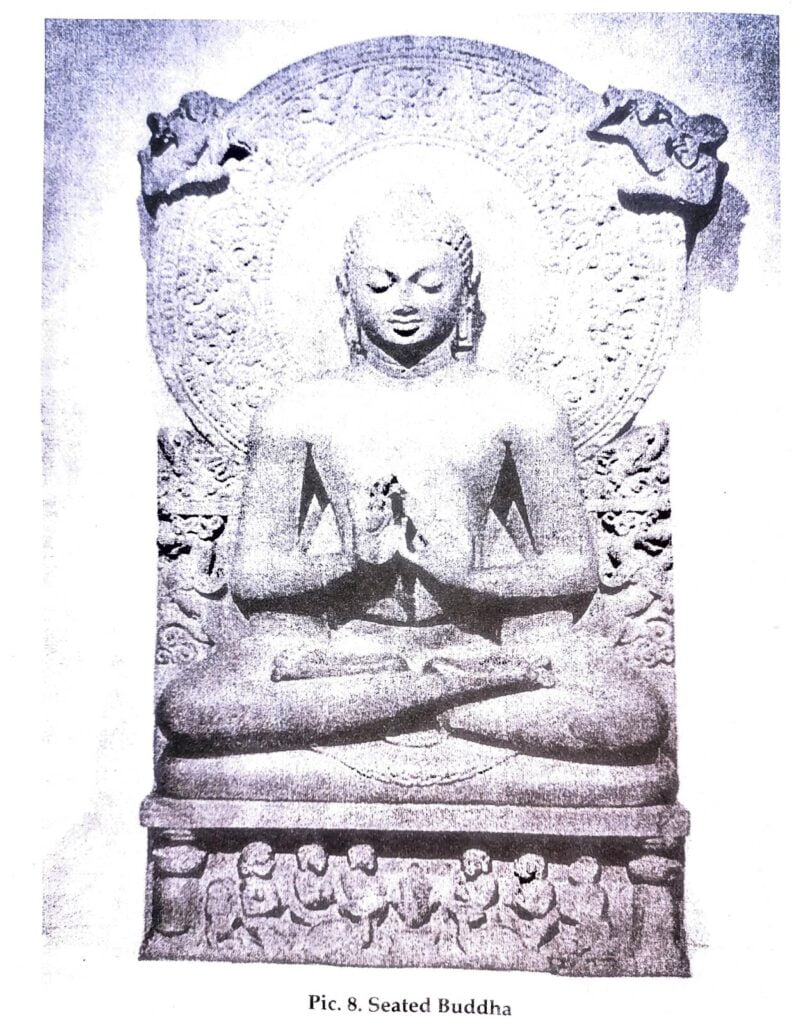
The beautiful figure is seated in Padmasana, with upturned soles. His hands are held in Dharmachakra Mudra. The ear lobes are long and the eyes are half closed. The face is calm with a spiritual expression. Behind the head is a big halo covered with a beautiful floral decoration.
This sculpture is one of the finest examples of Gupta art. The matured simplicity and rational use of ornamentation prove the skills of the artist.
Seated Buddha (Gandhara style) (Pic. 9)
| Title | Sarnath Buddha |
| Medium | Red Sand stone |
| Date | Kusana period |
| Finding site | Katra-Tila, Mathura, UP. |
| Size | Height – 75cm. |
| Artist | Unknown |
| Collection | Government Museum, Mathura. U.P. |
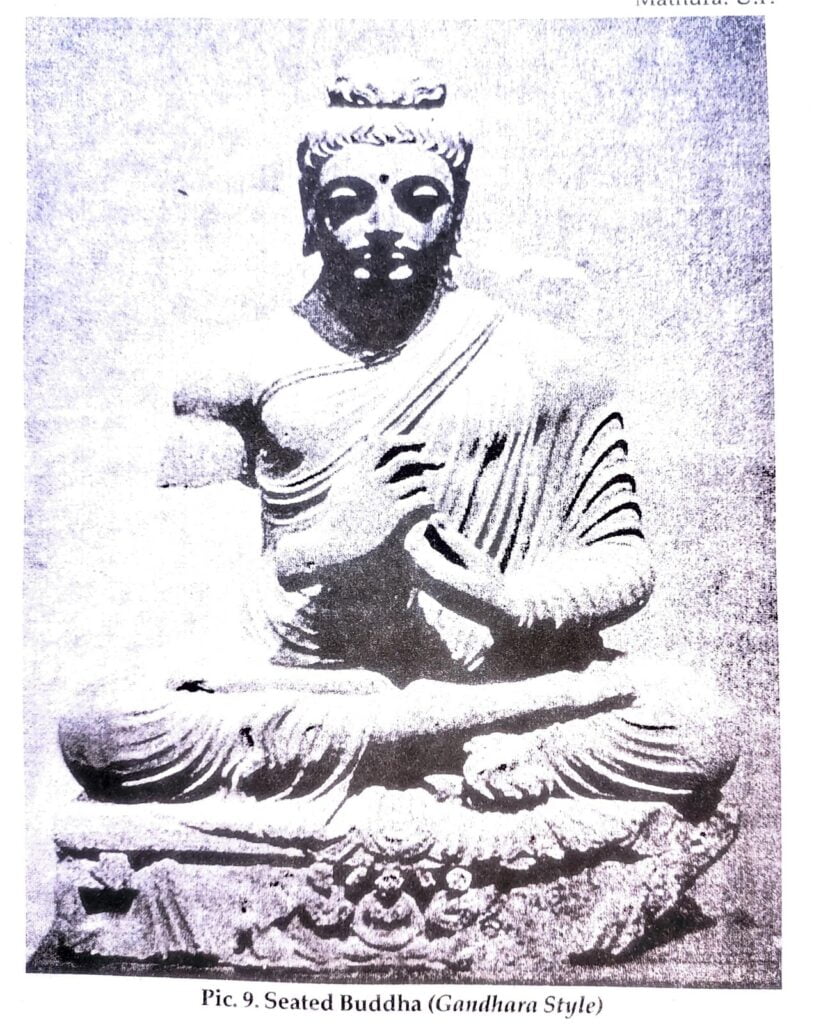
Gandhara is the ancient name of the territory on the western bank of the Indus river. The early school developed during the first and second century A.D. and came to its maturity during the time of the Kusanas. These sculptures were found from Taxila in the west to Sarnath in the east. The most important contribution of the Gandhara school was the construction of the Buddha image. This image shows realistic rendering of drapery and a tuft-like hair style on top of the head. One arm of this statue is missing, which probably was in Abhaya Mudra.
Intext Questions 2.1
Choose the right answer:
1. Lion capital of Sarnath is made of
(a) clay.
(b) marble.
(c) sandstone.
Ans: (c) sandstone.
2. The Sthambha was erected during the time of
(a) Chandragupta.
(b) Ashoka.
(c) Akbar.
Ans: (b) Ashoka.
3. The sculpture has been adopted as the emblem of
(a) Doordarshan.
(b) Delhi Govt.
(c) Govt of India.
Ans: (c) Govt of India.
Intext Questions 2.2
Fill up the blanks.
1. The Chauri bearer was found at “___________”
Ans: Didarganj, Patna.
2. It belongs to Maurya period because it has “___________.
Ans: High polish.
3. The Chauri bearer is mentioned as the Indian “___________”.
Ans: Mona-Lisa.
Intext Questions 2.3
Fill up the blanks.
1. The relics of ___________ was kept inside the great Stupa.
Ans: Sakyamuni.
2. The largest Stupa of Sanchi is known as___________.
Ans: Mahastupa.
3. The four Toranas were erected by the ___________ Dynasty.
Ans: Satavahanas.
Intext Questions 2.4
Choose the right answer.
1. The Jain Tirthankar Statue is now in
(a) National Museum, N. Delhi.
(b) Indian Museum, Kolkata.
(c) State Museum, Lucknow.
Ans: (c) State Museum, Lucknow.
2. The statue is in
(a) Abhaya Mudra.
(b) Bhumisparsa Mudra.
(c) Vajra Paryankasana Mudral.
Ans: (c) Vajra Paryankasana Mudral.
3. The image is of
(a) Buddha.
(b) Mahavira.
(c) Parsvanath.
Ans: (b) Mahavira.
Intext Questions 2.5
Fill up the blanks
1. The beautiful figure is seated in _________ Pose.
Ans: Padmasana.
2. Sarnath Buddha belongs to _________ Period.
Ans: Gupta period.
3. Hands of Sarnath Buddha are held in _________ Mudra.
Ans: Dharamachakra mudra.
Intext Questions 2.6
Fill up the blanks.
1. The seated Buddha belongs to the _________ style.
Ans: Gandharva style.
2. This statue is made of _________ stone.
Ans: Red sandstone.
3. The most important contribution of Gandhara school was the creation of _________ image.
Ans: Buddha.
Model Questions
1. What are the major contributions of the Mauryan to Buddhist art?
Ans: Chandragupta Maurya established an empire in India in the 4th C.B.C. For the first time, large portions of the subcontinent were unified politically. Chandragupta’s grandson Ashoka was the most powerful and popular emperor of this dynasty. He was a great lover of art and architecture. Out of his contribution to art, few pillars or stambhas and sculptures remain. These are found throughout his vast empire, particularly in and around Magadha.
2. Discuss the style of Gandhara Buddhist sculpture.
Ans: The most important contribution of the Gandhara school was the creation of the Buddha image. This image shows realistics rendering of drapery and a tuft-like hair style on top of the head. One arm of this statue is missing, which probably was in Abhaya Mudra.
3. Write the main features of the statue of Jain Tirthankara.
Ans: Many Jain images were found near Vidisha, which belonged to the early Gupta period. This image is of a Jain Tirthankar, seated on a square pedestal in Vajraparyankasana mudra. This image of Mahavira Swamy, the 24th Tirthankar, is made in the typical Buddhist and Jain style of the Kushana period.
Very Short Type Questions Answer
1. Who established the Maurya empire? When was it established?
Ans: Chandragupta Maurya established Mauryan empire in India in the 4th C.B.C.
2. What remains of Mauryan art and architecture can be found now?
Ans: Pillars or stambhas and sculptures.
3. Who came to power in India, after the decline of Mauryan empire?
Ans: Sunga and Satavahana.
4. What was Sungas contribution to art and architecture?
Ans: They build structures related to Buddhism. The finest examples are stupas of Bharhut and Sanchi.
5. What was the most important contribution of Gandharva school?
Ans: The most important contribution of Gandharva school was the creation of the Buddha image.
6. What is medium of lion capital at sarnath?
Ans: Sandstone.
7. Where was Chauri Bearer found?
Ans: Didarganj, Patna.
8. Which figure is called Monalisa of Indian art?
Ans: Chauri Bearer.
9. What is other name of Chauri Bearer?
Ans: Yakshini.
10. What is other name of Sanchi Stupa?
Ans: Mahastupa.
11. When was Sanchi Stupa built?
Ans: It was built during the time of Ashoka (circa 3rd C.B.C through 1st C.A.D.
12. Why was Vidisa famous?
Ans: Many Jain images were found near Vidisha, which belonged to the early Gupta period.
13. What are Tri Ratnas of Mahavir?
Ans: Faith, righteous work and truthful words.
14. What is the medium of the Seated Buddha?
Ans: Buff Sandstone.
15. How are hands held in Seated Buddha?
Ans: Hands are hands held in Dharma chakra mudra in Seated Buddha.
16. What is the medium of Seated Buddha of Gandharva style?
Ans: Red sandstone.
17. What do you know about Gandhara?
Ans: Gandhara is the old name of the territory on the western bank of the Indus river.
Short Type Questions Answer
1. Who came to power after the Mauryan empire? What were their contributions to art and architecture?
Ans: After the decline of the Maurya dynasty, the Sungas were the rulers of this empire. The Sunga and Satavahana period, that followed, contributed both in the field of Architecture and Sculpture. Most of these were related to Buddhism. The finest examples are the Stupas of Bharhut and Sanchi. The Kushanas arrived from the north western part of China and built an empire in the Northern part of India. Gandhara was the region situated on the western bank of the Indus river. The most important contribution of this school was the creation of the Buddha image. Buddha image appeared simultaneously in Gandhara and Mathura.
2. What did Gupta dynasty do when they took over power from Kusanas?
Ans: When the Gupta dynasty took over power from the Kusanas, it turned into a golden age for art and architecture. Artists of this age obtained great refinement in every form of art.
3. Describe Lion capital at Sarnath.
Ans: The sculpture of four lions grouped together, is the capital (Top part of a pillar) of the Stambh of Sarnath’s Deer park, which was created during the time of Ashoka. It is believed that it was at this site, Buddha preached his first sermon, thereby “turning the wheel of the law”. It was excavated in 1905. The Chinese traveler Hsuan-Tsnag mentioned of a seventy- foot high pillar with shining polish standing at the same site.
This composite sculpture shows a highly advanced form of art. This sculpture has been adopted as the emblem of Govt. of India.
4. Describe Chauri Bearer.
Ans: This female figure is also identified as a Yakshini and is often mentioned as the “Mona Lisa” of Indian Art. The figure is carved in the round with the perfect modeling of a female body. Because of the technique, surface refinement and high polish, scholars think that the beautiful life-sized sculpture belongs to the Maurya phase.
There are very few sculptures in Indian art that surpass its beauty.
5. Describe Sanchi stupa.
Ans: Stupa is the largest Stupa at Sanchi. It is known as Mahastupa. It was built during the time of Ashoka, and was enlarged to the present size by the Sungas. Probably a portion of the relics of Sakyamuni (Buddha) was kept inside the Stupa. During the second half of first century B.C. the Satavahanas erected the four beautifully carved toranas or Gateways.
6. What do you know about Jain Tirthankar?
or
What were teachings of Mahavira?
Ans: Many Jain images were found near Vidisha, which belonged to the early Gupta period. This image is of a Jain Tirthankar, seated on a square pedestal in Vajraparyankasana mudra. This image of Mahavira Swamy, the 24th Tirthankar, is made in the typical Buddhist and Jain style of the Kushana period.
In his teachings Mahavir Swami laid emphasis on freeing the human being from the cycle of birth and death, which can be achieved by practising Triratnas (three gems of action) like faith, righteous work and truthful words. The artist tried to express the Triratnas in this image.
7. Describe seated Buddha at Sarnath.
Ans: The beautiful figure is seated in Padmasana, with upturned soles. His hands are held in Dharmachakra Mudra. The ear lobes are long and the eyes are half closed. The face is calm and has a spiritual expression. Behind the head is a huge halo covered with a beautiful floral decoration.
This sculpture is one of the best examples of Gupta art. The matured simplicity and rational use of ornamentation prove the greatness of the artist.
8. Describe seated Buddha of Gandharva style.
Ans: Gandhara is the old name of the territory on the western bank of the Indus river. The early school flourished during the first and second century A.D. and came to its maturity during the time of the Kusanas. These sculptures were found from Taxila in the west to Sarnath in the east. The most important contribution of the Gandhara school was the creation of the Buddha image. This image shows realistic rendering of drapery and a tuft-like hair style on top of the head. One arm of this statue is missing, which probably was in Abhaya Mudra.

Hi! my Name is Parimal Roy. I have completed my Bachelor’s degree in Philosophy (B.A.) from Silapathar General College. Currently, I am working as an HR Manager at Dev Library. It is a website that provides study materials for students from Class 3 to 12, including SCERT and NCERT notes. It also offers resources for BA, B.Com, B.Sc, and Computer Science, along with postgraduate notes. Besides study materials, the website has novels, eBooks, health and finance articles, biographies, quotes, and more.


